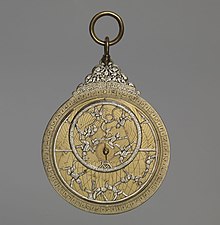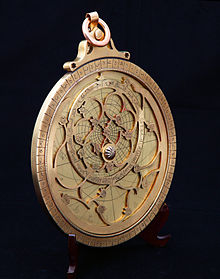Astrolabe
![]()
This article is about the ancient device. For modern devices, see prism astrolabe and Ni2 astrolabe. See also: Astrolabe.
An astrolabe (also astrolab, Greek for "star taker") or planisphere is a disc-shaped astronomical calculating and measuring instrument. It can be used to recreate the rotating sky and make calculations of star positions.
On a fixed disk (tympanum) are the horizon and circles of the horizontal coordinate system. Above this is the rotatable rete, which contains as celestial bodies some stars and the annual orbit of the sun (ecliptic). Some of many possible applications are as follows: If the rete is set to the date and time, the positions of the stars can be read. Conversely, the date and the position of a star or the sun can be used to determine the time or the points of the compass.
Mostly there is a diopter on the back, with which the elevation angle of an object on earth or in the sky (for example star or sun) can be measured above the horizon. The traditional Greek meaning of "star picker" or "star altimeter" comes from this additional device, which was also used in seafaring to determine the latitude before the sextant.
Astrolabes were used from ancient times until the early modern era. The two-dimensional star charts still in use today are simplified versions of the astrolabe. In the representation of the rotating sky, the more descriptive, three-dimensional planetarium has replaced the astrolabe.

Astrolabe of al-Sahl al-Nisaburi (front side), 1178 / 1191 or 1284 / 1299, Hama (Syria), today Germanic National Museum in Nuremberg

Iranian astrolabe (front side, modern replica)
.jpg)
Individual parts lifted from the front of an astrolabe, Mathematical-Physical Salon of the Zwinger (Dresden)
Display principle
The astrolabe is considered to be an armillary sphere transferred to the plane, which resulted in calling it today also spherical astrolabe and the astrolabe plane armillary sphere. The transmission is done with the help of stereographic projection. The centre of projection is a point on the armillary sphere or on the celestial sphere to be imaged. Preferred are the southern or northern celestial poles around which the sky (apparently) rotates. Since at the time of its invention the astrolabe was intended exclusively for the representation of the northern sky, the classical examples contain the projection from the south pole. The North Pole is the center and pivot point on the astrolabe.
In ancient times, the tradition was to prefer the view of the celestial sphere from the outside. Likewise, an armillary sphere is seen. The view from the outside was artificially produced in the astrolabe by mirroring the inner view of the celestial sphere obtained by stereographic projection. This can be seen primarily in the mutual arrangement of the star symbols on the rete and in their direction of rotation. The constellations seen from the Earth and those depicted on the rete are mirror images of each other. The rete rotates clockwise; from Earth, however, the sky is observed rotating counterclockwise around the North Pole.
Components and scales
Above the tympanum is the rotating, reticulated star disk (rete), whose small points serve as symbols (star pointers) for about two dozen selected bright stars in the sky. On the tympanum are images of the horizon and a grid of horizon coordinates. Since these images depend on the latitude of the observing site, they are displayed on interchangeable tympanums, one of which is inserted into the base plate (mater) of the astrolabe. This allows the astrolabe to be used in several latitude regions.
The base plate carries on its outer edge a scale of the 24 hours of a day (limbo, sometimes also twice 12 hours or a 360° scale).
On a tympanum the horizontal celestial coordinates between horizon and zenith are shown: Horizon, altitude circles (almucantarates) and azimuth arcs. The images are circles, because circles are always depicted as circles in the stereographic projection. In addition, the circles centered on the celestial pole are the celestial equator and the two celestial tropics. The arcs below the horizon are lines of temporal hours.
The rete shows individual stars (star pointers) and the ecliptic as a date circle marked with zodiac signs or directly with the calendar date. Seen from the earth, the sun changes its position relative to the fixed star sky in the course of the year, it passes through the ecliptic circle.
A rotating hand (ostensor) helps to set the date on the ecliptic by rotating it to match the time on the hour scale (limbus) on the edge of the mater. On some variants, the hand bears a declination scale.
On the back (dorsum) is a rotating double pointer (alidade) with a diopter, with which the elevation angle of a star can be measured. One of several scales is used for this purpose, and the astrolabe must hang exactly vertically on the retaining ring (armilla).
_02.jpg)
Back of an astrolabe with diopter (Alhidade)
Search within the encyclopedia